When students of California State University, Stanislaus were first prompted to sign up for the Emergency Notification System (ENS), otherwise known as StanAlert, they were informed they would “receive warnings during a campus critical incident.” The statement is still printed on ENS business cards available around campus.
Although it does not make clear just what qualifies as a “critical incident,” one would assume that an alleged weapon sighting on campus would make the cut for an emergency notification.
Unfortunately, that’s not what happened in practice. A call was received Oct. 24 reporting a weapon sighting on campus. Officers sporting assault rifles reportedly poured through the Mary Stuart Rogers building and Vasche Library.
Not a single student on campus was made aware of this potentially dangerous scenario through the ENS. In a system that claims to send warnings during “critical incidents,” this decision inspires doubt about just how safe students are kept by Public Safety.
Public Safety – also known as the University Police Department (UPD) – has been making a grand show of its presence on campus from groan-worthy videos about parking permits to Where’s Waldo on a Segway.
In its favor, UPD provides students with a “Student Right to Know Daily Incident Log.”
This log is a reliable and informative record of the crimes that UPD assists with both on- and off-campus. Information about these logs can be obtained by either calling or emailing UPD.
UPD also lends a hand to students who run into the occasional, aggravating pitfalls that life tends to throw. Take, for example, the classic “left your car lights on during class” scenario.
“If your car’s battery has died or if you have locked your keys inside your car, call the University Police,” csustan.edu states. “Be prepared to answer a few questions such as, where you are calling from, what type of vehicle you have and where you would like the officer to meet you to assist you.”
These practices are unquestionably helpful to the student body, but do they outweigh the seemingly blatant neglect of StanAlert?
“California State University (CSU) Stanislaus has implemented StanAlert, an emergency notification system (ENS) capable of rapidly sending voice, e-mail and text messages to faculty, staff and students,” the website reads in its introduction of the system.
“CSU Stanislaus officials use StanAlert to convey timely information— including urgent safety instructions—during an emergency or major situation affecting the campus.”
What defines a situation as “urgent?” At what time were they intending to inform students about the fact that there very well might be a dangerous person on campus?
“Nothing was found,” David Tonelli, Associate Vice President for Communications and Public Affairs, said. “As there was no confirmed safety risk to the campus, no emergency communications system was activated.”
The phone call was reportedly assumed to be a prank, seeing as nothing was found after the investigation – but what if it hadn’t been?
“Since 1990 campuses have had the requirement to provide Timely Warnings when a crime for which it must report statistics – such as homicide, sex offense or robbery – presents a serious or continuing threat to students and employees,” Lieutenant Reggie Thompson, Operations Commander of UPD, explained.
“Notification must be made upon confirmation of a significant emergency or dangerous situation involving an immediate threat to the health or safety of students or employees occurring on the campus.”
It should be noted that “confirmation” does play a role in the definition of a “Timely Warning.” This would seem to be the case in order to avoid mass panic on campus, but does it really achieve this end?
Especially considering the fact that a number of armed officers were present on campus without any real explanation to the students.
“If I see a police officer with a rifle, then I’m not going to think things are okay,” Ashley Stinson (junior, Psychology) said. “I’d rather be told what’s going on than left to just imagine.”
In response to this general concern, Lieutenant Thompson cited the 2008 Emergency Notification requirement that was added to the existing law:
“The campus community should be aware that University Police Officers may respond to reported incidents wearing and carrying equipment that may seem unusual,” Lieutenant Thompson said. “However, standards for police response have changed and it will become more common to see semi-automatic handguns, body armor, helmets and large rifles.”
He went on to urge community members to avoid panic, and assured that the university would make every effort to send out a notification should there be information the community needed to know.
What defines what the community needs to know?
The community should be able to dictate what they need to know, especially when it pertains to a potentially dangerous situation.
The National Institute of Justice (NIJ) wrote a piece in journal no. 248 entitled “Preventing School Shootings.”
One quote in particular is chilling and emphasizes the importance of immediate response:
“Most shooting incidents were not resolved by law enforcement intervention,” the NIJ states.
“More than half of the attacks ended before law enforcement responded to the scene – despite law enforcement’s often prompt response. In these cases, faculty or fellow students stopped the attacker. […] Schools can make the best use of their resources by working with law enforcement on […] critical incident response plans.”
When there are officers with assault rifles present on campus, at what point should we be concerned?
Categories:
Weapon sighting on campus, not critical?
By Noel Daniel
•
November 15, 2013

0
Donate to Signal
Your donation will support the student journalists of California State University, Stanislaus. Your contribution will allow us to purchase equipment and cover our annual website hosting costs.
More to Discover






